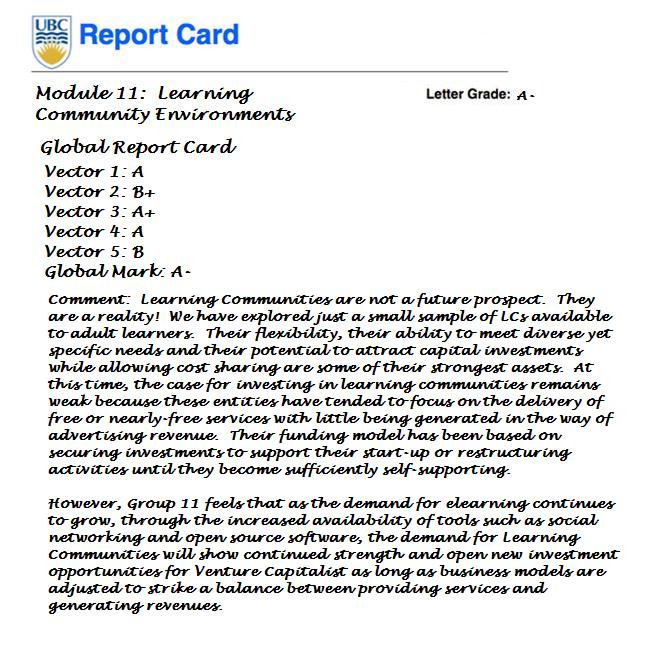Course:ETEC522/2010ST1/LearningCommunityEnvironments/Concluding Remarks
Concluding Remarks

It is an undeniable fact that humans are social beings. They come together to trade knowledge, to entertain themselves and to seek shelter from the elements, both real and figurative. And they leave knowing they are stronger for having entered into a collaboration. The internet is our modern version of a meeting place. Professional Learning Communities are a natural evolution of our desire to combine socialization with fulfilling our needs. They benefit us in a variety of ways, making us more knowledgeable at a cost efficient price and allow us to be more competitive on a personal or global scale. Their biggest drawback is the loss of autonomy and potential for political problems within the community as power struggles may emerge.
Professional Learning Communities take many forms – Online Learning Consortia, Library Consortia and IT Consortia are examples of large scale PLCs. They can be more informal and require little more than a group of people meeting to discuss issues that they want to explore.
Group 11 feels that PLCs will continue to gather momentum and increase in number and variety in coming years. The continued increase in demand for elearning is a driving force for academic Consortia. Post-secondary institutions cannot command the start-up funding required and sustain the operational costs of an ever-increasing distance learning inventory. Such has been the fate of BC where the number of online Distributed Learning schools has steadily been shrinking. Due to mounting costs and declining enrollment, six public school districts (all rural) folded their online programs between 2007 and 2009 and are now relying on other school districts or learning communities to provide e-learning options for their students (Winkelmans, 2010). By coming together to share resources, particularly infrastructure, post-secondary institutions across Canada are finding they can meet increased demand and produce high quality courses, which is their mandate in the first place. Rather than outsourcing, a group of educational institutions can create their own Consortia to handle infrastructure and administrative matters such as CMSs, student enrolment, credit transfers and course marketing.
Tony Bates wrote about the future of elearning in his blog. These are his predictions on the probability of establishing a Canadian Open Content Consortium:
“This would have two main purposes. One would be to help increase the development of shareable high quality digital resources. The second would be to develop design strategies for open educational resources. This would include how best to create open content so that it is more likely to be re-used; and models for how best to apply existing open content in teaching. This consortium would cover the whole range of education, from k-12 to lifelong learning. It would address the problem of poor uptake and poor quality (in terms of re-usability) of existing open educational resources. It might also focus on innovative assessment strategies, such as the use of e-portfolios based on at least partial use of open educational resources.
The consortium’s activities would be partly research, partly developmental (most open content would be developed as part of the partner institutions’ normal activities, but working to agreed or emerging design standards.) The consortium would seek some research funding from national research agencies and the Hewlett Foundation, but would be mainly self-financing though institutional membership fees. Athabasca University would be a natural partner, as would other members of the Canadian Virtual University, but membership would be widened through a co-operative association model to bring in conventional universities, colleges and school systems. The consortium would have close links with other open educational resources agencies in other countries.
I give this a higher probability rating (60-70%), because there is already a potential core base in place, and already there have been contacts between various Canadian institutions at conferences regarding collaboration on open educational resources. The new part of this proposal would be greater focus on the design and application of OERs, and some earmarked funding for this activity.” (Bates, 2009)
Final Report Card
Before you go...
In the true spirit of a Learning Community, each member of our group has contributed knowledge and expertise to study a common topic. You may be interested in knowing that although some of the vectors were evaluated by more than one person, each of us brought our unique skill set to the final product. Much of the work happens behind the scenes in the form of formatting, finding appropriate images and video and just managing the process. Thanks to the tools available through the web 2.0, we managed to find a common meeting place, in spite of great geographical distances, differing time zones and inequities of access to technology. This, however, represents the reality of all collaboration. We have come together and left stronger, more knowledgeable and more competitive for having shared. We hope you enjoyed sharing with us.
Kereen, Denise, Devinder and Catherine

Please take a moment to visit Survey Monkey and evaluate our wiki presentation. Click here to take Survey
References
Bates, T., & 2009. (2009, December 20). Six priorities for Canadian e-learning in 2010 « Tony Bates. Tony Bates. Retrieved July 11, 2010, from http://www.tonybates.ca/2009/12/20/six-priorities-for-canadian-e-learning-in-2010/
Winkelmans, T. (2010). Ministry of Education: eLearning Programs Update, April 2010. Virtual School Society Spring Conference: 21st Century Learning & Sharing, Engaging for Success. 23 April 2010. Retrieved 2 June 2010 from https://sas.elluminate.com/site/external/jwsdetect/playback.jnlp?psid=2010-04-23.0946.M.CDC64A55F1930F68CD9B754ECCCA98.vcr
Return to Vector 5: Future Potential
Go to Discussion/Case Studies
